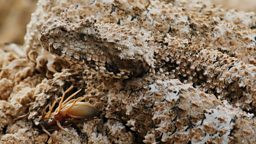Nature's most devious con artists
Our top five countdown of nature's most cunning con artists.
5) Spider-tailed Viper

A spider-tailed viper might sound nightmarish but it’s a snake that’s evolved a cunning solution to catching a meal where resources are scarce.
A snake that’s evolved a cunning solution to catching a meal where resources are scarce.
Until 2006 examples of these snakes found in the Iranian desert were passed off as having growth abnormalities.
It was only when they were observed expertly using these spider-like appendages to lure birds within their grasp that they were recognised as a species in their own right.
Key fact:
Local bird species rarely fall for this trick. Migratory birds with no knowledge of the snake’s tactics seem to form of bulk of its prey.
4) Orchid mantis

These ingenious insects have evolved to mimic the flowers they hunt from, with four of their legs resembling petals.
When their pollen-hungry prey hover within range they strike.
They are ambush predators and when their pollen-hungry prey hover within range they strike.
A mantid rarely misses its mark!
Key fact:
As well as looking like the flowers they sit on, orchid mantids also emit flower pheromones more efficiently than the flower itself, attracting even more prey to within their deadly reach!
3) White-winged choughs

The gregarious white-winged chough lives in super-social family groups of up to 20 individuals.
Raising young in the Australian bush is no mean feat!
Many hands make light work and raising young in the Australian bush is no mean feat! You need all the help you can get!
To get the assistance they need these devilishly clever choughs are always on the lookout to kidnap new members to join their team. They do this by performing a dance called a ‘wing wave tail wag’ luring young fledglings of other family groups to come and join their own.
Key fact:
Scientists have estimated it can take up to 7 adult choughs to successfully raise just one chough chick.
2) Photuris firefly

After a female femme fatale firefly mates with a male she undergoes a sinister transformation. Rather than retreat to lay her fertilised eggs in peace she continues to signal for males.
When the hopeful males fly within range… she eats them!
Though this time romance is not on the agenda!
Female Photuris fireflies cleverly mimic the mating signals of several different species of firefly. When the hopeful males fly within range… she eats them!
Key fact:
Why does the femme fatale resort to this dastardly behaviour? It’s all down to lucibufagin, a steroid produced by some species of fireflies to make them unpalatable to predators. Photuris fireflies don’t make lucibufagin, so they steal it from others by eating them.
1) Octopus

Whilst other animals might have evolved perfect camouflage for the environments they inhabit, octopus have taken hiding to a whole new level.
Octopus have taken hiding to a whole new level.
Using chromatophores (cells containing pigments) in their skin to change colour, and muscle fibres called papillae to mimic the shape of the reef around them octopus have evolved the ability to hide in plain sight.
But it's knowing how to use these abilities - which pattern and when - that is truly astonishing.
Key fact:
Cephalopods like octopus change their shape and colour up to 170 times an hour. Every one of these changes is a result of detailed, complex analysis of the environment around them.




